
Tranalysis
Although many classic Western paintings are exhibited in China, for most people, appreciating Western art works is still more through the screen, and the original works are difficult to see, let alone the frame-however, the frame is actually very important, because it tells the role of a work (painting or sculpture, etc.) at the time.
Alison Wright, professor of art history at University College London, studied Italian art from 1300 to 1550 and was the originator of frame theory, an important theory in current Renaissance research. The theory holds that frames and frame installations were at the core of the image operation during the Renaissance, and that during a period of rapid cultural change, frames began to ensure an independent concept of "art"; and rearranging the frame could adjust the meaning of the work of art.
Recently, Alison Wright accepted an exclusive interview with The Paper Art in Shanghai. She believes that Western painting theory is closely related to the larger framework theory, which not only originates from art history, but also is rooted in literary theory and communication theory.

Alison Wright, professor of art history at University College London, gave a public lecture titled "Elevation and sacred space in Renaissance altar decoration" in Shanghai.
Alison Wright, as one of the scholars in China participating in the series of activities "Dialogue among Outstanding Scholars in World Art History·Art and Culture of the Renaissance" initiated by the Institute of World Art History (WAI) of Shanghai International Studies University, delivered a public lecture titled "Elevated and Sacred Space in the Decoration of the Renaissance Altar" in Shanghai. The lecture content is derived from her book "Framed Painting: Glory and Decoration in Italian Renaissance Art ", which explores how" decoration "in Italian Renaissance paintings and sculptures (including the physical frame and pedestal itself, as well as the fictional architectural elements and other auxiliary elements within the work) embodies and influences social relations and meaning.

"Frame Painting: Glory and Decoration in Italian Renaissance Art", by Alison Wright, Yale University Press, 2019
During her visit to China, Alison Wright also gave a lecture at Peking University entitled "The Golden Chapel of St. Zakaria: Space and Times of Venice's Gold"; and held "Gold: Speciality and Differences" at the China Academy of Art in Hangzhou. The workshop is related to her ongoing work on a book tentatively titled "Gilded Cities: Golden Politics and Performance in Europe 1350-1550 AD."
The exclusive interview also focused on frame theory and gold research, mentioning the relationship between Van Eyck, Donatello, and Raphael's works and picture frames, and extended to the framing of Chinese paintings and the entanglement between East Asia and Europe's visual culture, as well as prehistoric bronze casting in China and bronze sculptures in the Italian Renaissance.
About Frame Theory
The Paper: As the "originator of framework theory", how did you first pay attention to this theory?
Wright: While I was a doctoral student, I attended a workshop on the San Miniato al Monte in Florence, built for James, the prince and cardinal of Portugal (James died in exile in Florence in 1459, and construction began in 1462, with inscriptions on the wall indicating that the church was completed in late 1466), and its architect was Antonio Manetti.

On the hill near Piazza Michelangelo, Florence, the Chapel of San Miniato Almonte, a small Romanesque church.
During a field visit to the chapel, I discovered that the frame in the middle of the altar painting was embedded in the wall and was associated with the building components next to it. The world in the frame is not just a painting, but also a sacred space. The original altar painting is now housed in the Uffizi Museum in Florence. It is believed to be a work jointly created by Antonio del Poleyulo and Piero del Poleyulo. It depicts three saints. When you are around it, there is a real revelation.

"Altarpiece of the Cardinal of Portugal," murals and curtains painted on the wall around the altar (replica of the painting, the original is now in the Uffizi Art Museum), 1460-1473, Chapel of San Miniato Almonte, Florence
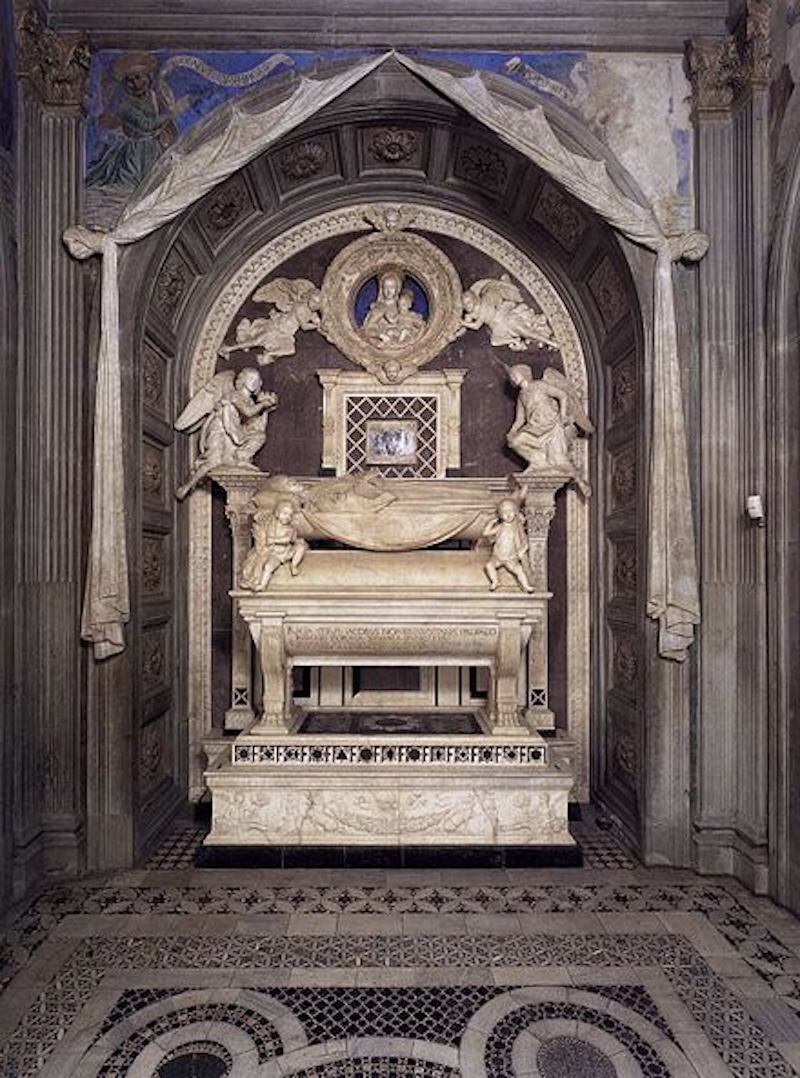
To the right of the altarpiece, the tomb of the Portugal Cardinal
On the right side of the altar is the tomb of the cardinal, and on one wall there is a marble statue designed by Antonio Rossellino. Two angels above it opened the curtain, and the framework became some kind of gateway to the world, expanding the world of the church. And the church itself is full of arched nested frames-the frames around the painting, then the frames around the walls, then the arches of the church. As a result, the study of picture frames and frames began to enter my field of vision.
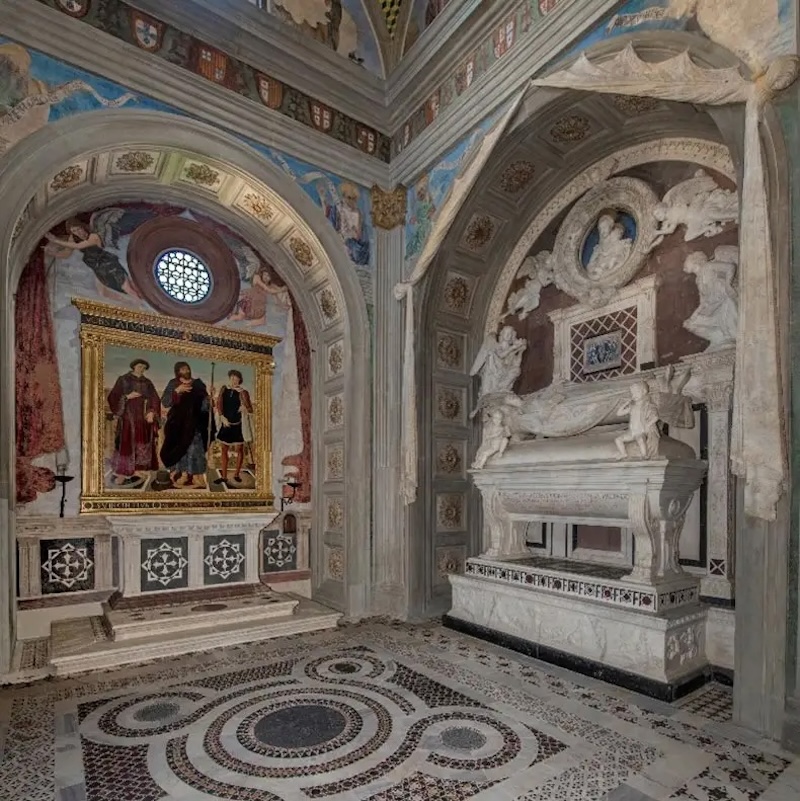
The altarpiece and tomb of the Portugal cardinal in the Chapel of San Miniato Almonte.
The Paper: During the Renaissance, what role did decorative frames play in art works? How are they designed and used to highlight the theme and aesthetic characteristics of the work?
Wright:Frameworks have many different roles. One of the most familiar phenomena is the use of frames to make the viewer feel like they are an independent painting, and the frames no longer fix the works in a certain position, allowing them to be moved from one place to another for collection.
For example, the British National Gallery has a portrait (considered a self-portrait) of the northern Renaissance painter Jan van Eyck, with an inscription engraved on the frame-"as I can"-which seems to be a pun. The words "Johannes de Eyck me facit" are written on the bottom of the frame. Sometimes this practice suggests that the painting itself is a reproduction, with the frame as if Van Eyck himself was seen through a window.

Van Eyck, Portrait of a Man (or Self-Portrait), 1433, 26 x 19 cm, National Gallery
However, I study more about the frameworks that must be fixed. For example, you walk into a church and see the frame of the Eucharist shrine. The purpose of the framework is to tell believers that this is a gift from heaven and is for others to worship. You will find arches, mountain flowers and nested frames placed around the shrine to indicate that it is God's dwelling place. Without these, it would be almost impossible to identify that the Eucharist was just a piece of bread (note: Jesus 'body became bread), and the study of these elements is all part of the framework theory.

Mina da Fiesole (1429-1484),"Tabernacle", circa 1473, Church of the Holy Cross, Florence
In Italy, the frame may be angels under the arch, carrying inscriptions and walking towards the door. Many people are interested in the frame of portraits of the Virgin Mary, which have worked miracles. The frame is also a way of paying tribute to the person in the painting or the portrait itself. The frames of the altar are beautiful and complex, and they are believed to provide a beautiful dwelling place for God.
There is also an example of the "Annunciation", which is an embossed done by Donatello in the Church of the Holy Cross in Florence. It has a huge frame, heavy and complex in structure, recreating ancient patterns in a very creative way. I think this framework has a very strong aesthetic character, but it is a shrine and the theological reasons for its existence are more important.
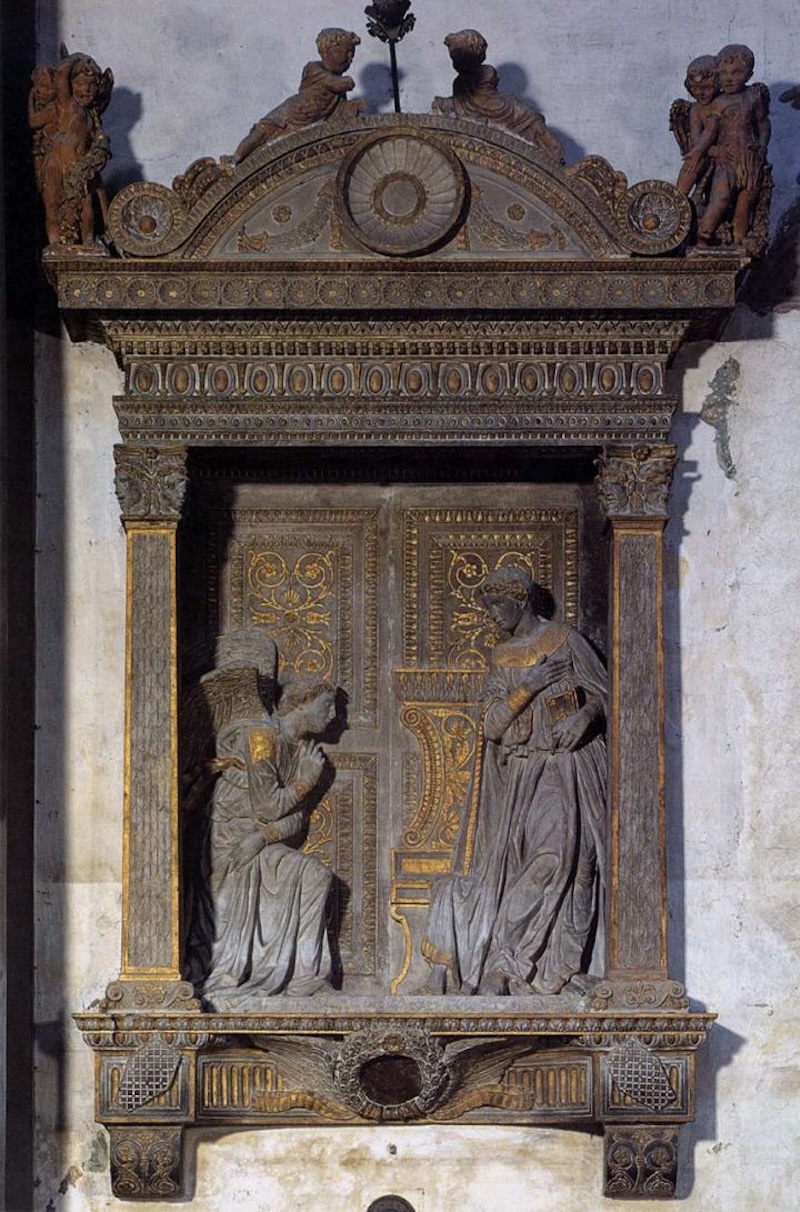
Donatello (1386-1466),"The Annunciation", circa 1433-1435, in the sixth compartment of the south corridor of the Basilica of the Santa Croce in Florence
The Paper: In early May, the 19th century Gothic frame originally attached to the "Portrait of Anofini Double" by Jan Van Eyck at the National Gallery of the United Kingdom was replaced by a 15th century gold-plated frame. This replacement caused a polarized reaction. What do you think of this replacement? [Note: Peter Schade, head of the framing department at the National Gallery, said,"Without the competition of incongruous carving, the characters appear larger and the details are clearer"]
Wright:Because this happened recently, I haven't seen its new frame with my own eyes. I saw the reports and was very concerned that "Portrait of Anofini Double" was given a new but older frame. This was a very brave move. "Portrait of the Anofini Double" is one of the most famous paintings at the National Gallery of England and one of the most important Dutch paintings, but it is so small that it often surprises viewers who see this work for the first time.
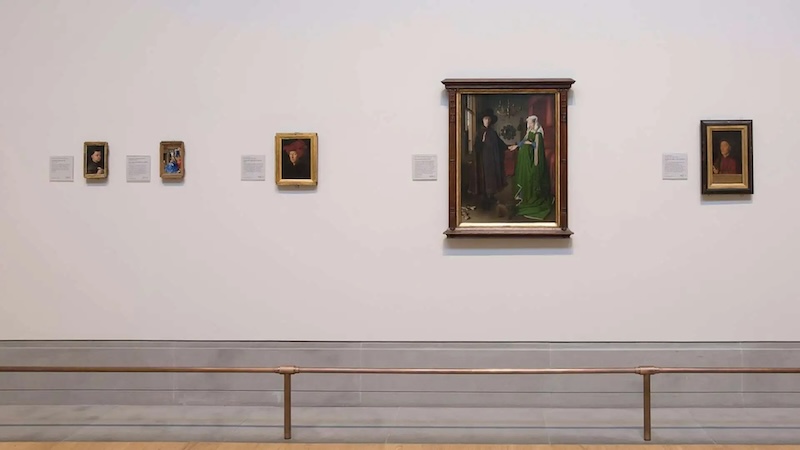
The newly framed "Double Portrait of Anofini" displayed at the National Gallery of the United Kingdom, with Van Eyck's "Portrait of a Man (or Self-Portrait)" on the left
In fact, what interests me is the old picture frame. This is a dark wooden picture frame from the 19th century that looks somewhat Gothic architectural. Make the audience think this is a medieval work. Now Peter Shad, head of the framing department at the National Gallery, has adjusted a gold frame that almost certainly comes from 15th century Italy. The current frame makes the painting feel more forward-looking, even though it is an older frame.

Peter Shad compared the old and new frames on his social media and believed that the new "characters look larger, the details are clearer, and there is no interference from incongruous carvings."
I have two concerns about this change. First, why would you want to replace the original 19th century frame? I think the original one is very beautiful. Although it may not be perfect, it does not hinder the display of the painting. Moreover, it has been presented in this way for so long, the frame has become an important part of the history of this painting. I think for such an important work, before deciding to replace the frame, you have to be very sure that it really fits because it is changing the history of the National Gallery.

Van Eyck, Double Portrait of Anofini, 1434, 82×60 cm?
Another concern is that the new frame used is a dull, dull gold frame. This is very similar to the frame Van Eyck might use for a small portrait, and in fact, the same frame is also used for his self-portrait at the National Gallery I mentioned earlier. So when I saw the new frame, I felt that the painting's rather magnificent state had changed visually. The old frame looked like a threshold, and it made you feel like you were looking at a room, and at the end of the room there was a mirror with a huge frame.

Van Eyck,"The Double Portrait of Anofini"(Part)
Therefore, the idea of the entire painting is to make the audience feel like they are entering someone's room. In fact, if you look in the mirror, you will find someone standing at the door in the mirror, as if you had just walked in. So the painting attempts to create a feeling of people entering the wealthy couple's home and being welcomed, and the dog being greeted. This is not only an intimate painting, but also has a considerable sense of ceremony.

Van Eyck,"The Double Portrait of Anofini"(Part)
But in the new frame, the characters look smaller and have a different sense of space. It looks like you entered the room through a window rather than a door. I think I need to get used to the new frame, and I prefer the feeling conveyed by the previous frame, even if it may not be completely correct. This painting has a solemn atmosphere, which is well reflected in the previous frame. Peter Schad is a very good frame maker, and he might understand how I feel.
The Paper: The decoration of architecture and public spaces has also been included in the category of frames, such as Baroque works and picture frames, Baroque sculptures and architectural construction, and what are the relationships and boundaries between painting and frames?
Wright:I think this issue can be divided into two parts. First, during the Renaissance, painting frames were often embedded into larger frames (such as home environments), and many paintings hung high on walls above furniture (such as the statue of the Virgin and Child). Therefore, the painting is not just an individual decoration, but part of the overall decoration. Especially in churches, there are usually many altarpieces in a church, so the frames of these paintings often compete with each other. The frame patron must consider both the type of painting he or she wants to commission and the location of its placement. As a result, the altarpiece frame would be correlated with other decorations in the church, such as architectural frames or paintings on the walls. The framework must intervene in the space that already exists and change that space.
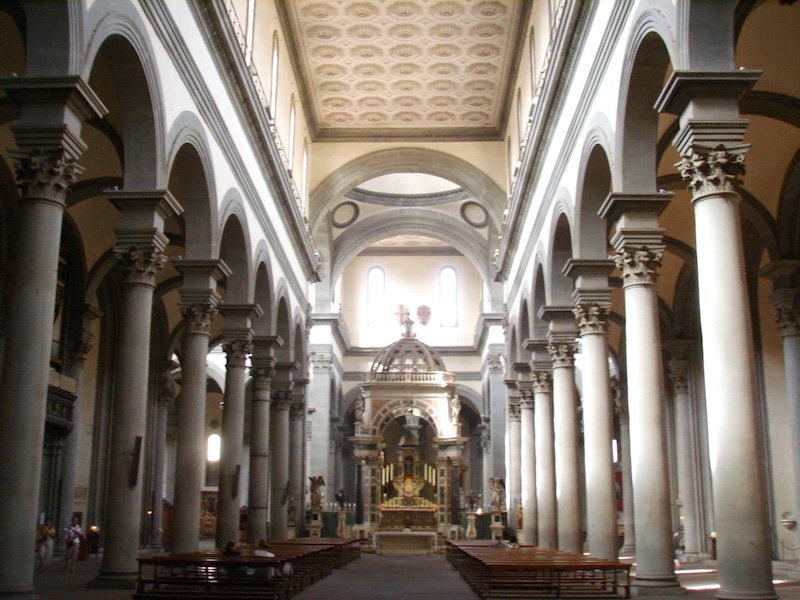
Interior view of the Church of the Holy Spirit in Florence
In my research, I found that some interesting phenomena that occurred during the Renaissance developed in certain church buildings in an attempt to bring some order to the space of this framework. For example, Filippo Brunelleschi's Basilica di Santo Spirito (Florence), which is a church with many columns, all of which have the same type of frames, and you will see a kind of heavenly order in which hanging anything here will seem out of place. I think this is an important aspect of the relationship between painting and framing, especially for religious art.

Giovanni Bellini (circa 1435-1516),"The Altarpiece of St. Job", circa 1480, the original work is now in the Accademia Gallery of Venice
For many secular art, the role of frames may be slightly smaller because the frames are often replaced. When redecorating a room, you may update a frame for the paintings you own.
So, what is the boundary between painting theory and picture frame theory? This is difficult to answer, because I don't just focus on painting, but also involve frame theory related to painting, which has become a specialized area of discussion since the 20th century. For example, Meyer Schapiro (American art historian in Lithuania, 1904-1996) talked about the role of picture frames, arguing that without frames, paintings would be like part of the world, but with frames, they seemed to say,"Look at the different world here." This is a typical framework theory. Others like Georg Simmel (German sociologist and philosopher, 1858-1918) simply see it as a boundary that allows the viewer to focus on the picture. There are also scholars, such as Louis Marin (French philosopher, historian, semiographer and art critic, 1931-1992), who believe that the picture frame is a place of expression. Invite you to think, especially in paintings from the 16th century, where you will see many frame-within-frame phenomena, forming a self-aware painting expression.

Pierre-Hubert Subleyras (1699-1749), Studio, 1740s, 125 x 99 cm, Collection of the Vienna Academy of Plastic Arts
For example, if a work depicts flowers in a niche, which itself is flat, but appears to have a frame and a frame on the outside of the work, this effect of Renaissance painting has become a personal research interest for me. In book illustrations manuscripts, images can also be seen side by side with text and appear to be framed paintings. These illustrations usually have landscapes or other elements and are very complex. This painting theory is closely related to the larger framework theory, not only derived from art history, but also rooted in literary theory and communication theory.
The Paper: Frameworks are mostly considered to be a study of the social background of the work. Will such research in turn affect the judgment of the work itself? In cross-cultural research, how does framework theory help us understand the differences and commonalities between different cultures?
Wright:I think it affects, as we discussed before, that the content of the work can be understood through the framework in which it is located. The examples I gave earlier also show why I think frameworks have a great influence on the evaluation of art.
For example, Jan van Eyck knew that if he wrote "Jan van Eyck made me" on the frame, people would think it was the work of a great painter, and the person who painted the painting was the subject of the painting, which is very clever. Therefore, this is both the theme and the painter, which will indeed affect the evaluation of art in later generations.
Also in the previously mentioned example of Van Eyck,"Portrait of Anofini" originally had a slightly Gothic frame in the 19th century, making it seem that it is a painting older than reality. However, we often ignore picture frames, and people rarely talk about them when conducting art history research. When we look at paintings now, we often see them on the screen. In many cases, we have never seen the original painting, and we don't even know what the frame looks like. However, in the study of art history with social and political connotations, the frame is very important. Because the frame tells you a lot about the role of a painting or sculpture at the time.
Of course, every time the frame is changed (which is particularly common in museums, especially around exhibitions), it changes people's evaluation of the painting to some extent. An example we often mention is the Raphael painting "Our Lady of Sistine" collected by the Gallery of Masters in Dresden. This painting has three or four different frames, and each change conveys a different message.

Raphael, Our Lady of Sistine, 1512-1513, 265 x 196cm, Gallery of Ancient Masters Dresden;
Left: A cartoon by Hans Gyenis (post-1873-1926), published on January 13, 1908, right: A photo from the 1920s, both pictures show the painting in a frame made in the 1850s.
Initially, it had a Dress-style frame and wanted to highlight the painting as a Dress-style collection. Later, it was replaced with a cassette frame that looked more like a window frame. Recently, it was reinstalled in a frame that made it look like an altarpiece, when it was actually painted as an altarpiece.

After World War II and travel to Russia,"Our Lady of Sistine" was enclosed in gilt and blue lacquer frames; right, the most recent frame was made in 2012.
But this frame is not from the Renaissance, but from the 21st century. Sometimes I even wonder if some people might think this is a Renaissance box? The Dresden Masters Gallery wants the audience not only to think that it is a masterpiece by Raphael, but also to realize that it was once an altarpiece with a specific social function.

Wang Lianming, associate professor at City University of Hong Kong, mentioned three cases in his speech.
The Paper: Associate Professor Wang Lianming of the City University of Hong Kong mentioned in his speech at your lecture that "Picture frames, as a conceptual category-presuppose functions as contact points or boundaries between culture, tradition or artistic practices, which greatly enriches the reading of art history in recent decades." He mentioned East Asia and its entanglement with European visual culture. How do you view this entanglement? [Note: The original text of Wang Lianming's speech read,"When paintings from the Southern Song Dynasty (1127 - 1279) arrived in Japan, they were cut into small pieces and remounted with brocade to adapt to the viewing habits of Japanese generals 'teahouses. In the 18th century Qing Dynasty, when the emperor collected a Neolithic jade, it was integrated into a miniature rosewood screen, effectively 'recreating' an artifact from an unknown historical period. Similarly, when Chinese blue and white porcelain was collected and displayed in early modern Europe, the metal frame became a necessary device, or as Monica Juneja of the University of Heidelberg put it,'it reinforced the perception of motivation-based cross-cultural connections that is often lost in studies of circulation or flow out of place.'"]
Wright:Lian Ming put forward a very good point, that is, when these works are collected, they are often marked (mounted) into someone's collection and recorded in the book. There is such a tradition in Western Europe and China. I think China is even earlier, because China has long had the practice of gathering collections together, and collectors always want to do something special to their collections.

Wang Lianming cited the example of "When Chinese blue and white porcelain was displayed in early modern Europe, the metal frame became a necessary installation"-a Chinese vase was "mounted" into a German wine pot
What is particularly interesting is that in the research of Anna Grasskamp (University of Oslo), we can see that when Chinese porcelain bottles entered the art market, they were both a commodity and regarded as a work of art from a foreign country. "Mounting" a Chinese vase into a German wine pot has divorced itself from its original culture and taken possession of it in the Western cultural context. This is to some extent a political act that makes this item understandable within the new "framework". This framework is from a Western perspective and also expresses a desire to tame the item in accordance with one's will and understanding.
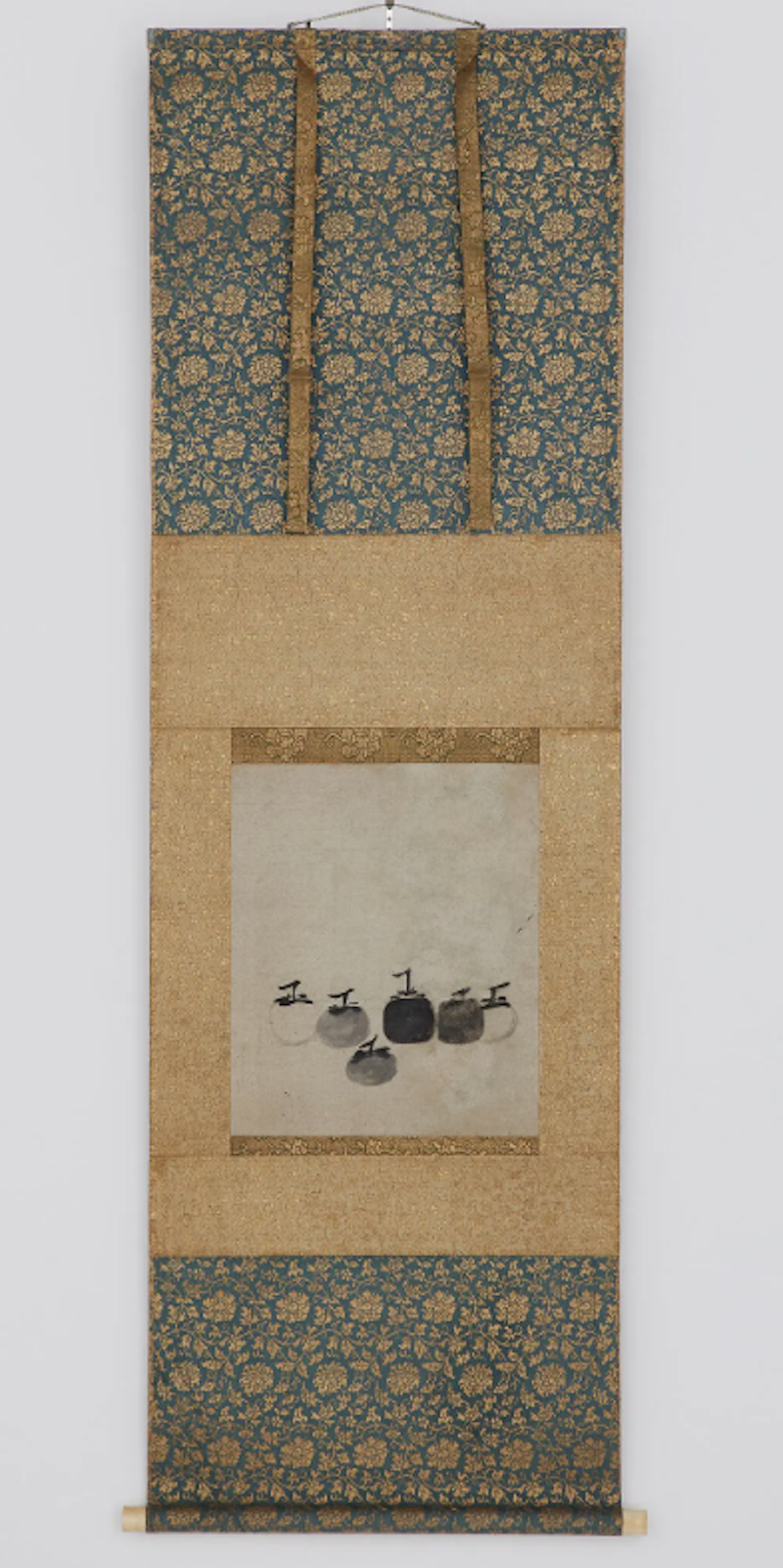
Muxi,"The Painting of Six Persimmon", 13th century, collected in Daoji Temple, Kyoto, Japan
I think the 18th century was the era of globalization of collections, when people used collections to name and classify objects. "Mounting" is becoming increasingly important, and all collectors, whether in Beijing or London, tend to remount the original scroll, but cutting off the original long scroll and remount it is a rather violent act. Jacques Derrida (one of the most important and controversial philosophers of our time (1930-2004)) believes that this is a violent cutting, where when Chinese scroll painting is cut, it no longer becomes part of the story or the larger viewing process, but becomes something you have to pay attention to.

The scroll of "Women's History Addictions" collected by the British Museum is divided into three parts and displayed horizontally
Mounting determines to some extent how we view and understand works of art. Through the choice of frames and mounting methods, objects gain new meaning and interpretation in new cultural and social contexts. Or it can be understood that when these items from China are brought to Europe, they are mainly appreciated as value-added assets rather than used as practical containers. In order to localize the functions of these items, traders often add gold or other metal decorations to give these items a certain purpose so that they can be appreciated as works of art or used daily.
Research on Jin
The Paper: Your current research involves the changing golden aesthetics and material economy in Renaissance art. What do you think of the widespread use of gold in Renaissance art?
Wright:I think we should pay special attention to the widespread use of gold in Renaissance art. Renaissance art is often compared to medieval art, which features golden surfaces, golden frames, and golden instruments. In contrast, the use of gold in Renaissance art was not emphasized. But in fact, gold paintings were still heavily used in Renaissance art, especially in the early 15th century, and in certain areas of Italy until the early 16th century. However, this is not always recognized, because people often think that these works are somewhat outdated and inconsistent with the latest aesthetic tastes of the time.

Spinello Aretino, Niccolò di Pietro, Lorenzo di Niccolò,"The Altarpiece of Santa Felicita", 1401, painted in the Church of Santa Felicata, Florence, now in the Academy of Florence
The main reason for this is that most of the history of Renaissance art is written from the perspective of Florence, which stopped using large amounts of gold decoration on paintings earlier than other regions (although gold-plated frames were still used), but the use of gold in medieval art was largely continued in places such as Venice, Milan or Naples, and even Spain.
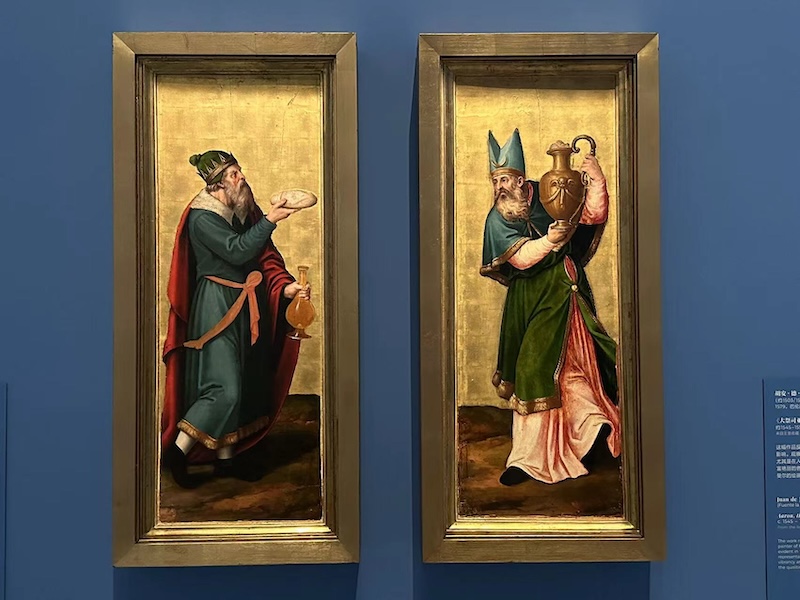
"Melchizedek, King of Salem" and "Aaron the High Priest" by the Spanish painter Juan de Juanes (circa 1510-1579) are in the Prado Museum and are currently on display in Shanghai.
Why is gold so difficult to abandon completely? One reason is that a large number of religious art works dominated during the Renaissance. Gold was a way to show the preciousness of subject matter and could symbolize heaven. Painters used gold to show sanctity. Painters such as Van Eyck used simulated gold such as yellow and brown, while Venetian painters directly gilded the surface of their works, making belts and other decorations appear three-dimensional and textured. Even some altarpieces in Venice have very few actual parts drawn, and the gold frames and gold decorations on the characters are eye-catching enough.

The Golden Chapel of Santa Zakaria in Venice
During the Renaissance, painters were also sculptors or goldsmiths. Gold is used not only for its own value, but also because it can attract the attention of the audience and mark the excellence you see. This is also the reason why gold is used in the halos of the saints in the paintings, indicating that these characters have extraordinary virtues and heavenly glory.

Fra Angelika,"The Coronation of the Virgin", circa 1432-1434, egg color paint board painting 209 x 206 cm, Louvre, Paris
In addition, for sponsors, they like to show off the gold they can afford, but what they actually use is gold foil, which may seem expensive but not costly. A small piece of gold foil can spread over a large area, creating a large number of golden effects. Therefore, another attraction of gold's continued use in Renaissance art is its efficiency and relatively low cost.
The Paper: What is the relationship between golden aesthetics and artistic creation?
Wright: I want to give two examples. One is sculpture. I have written a lot about all-gold-plated bronze sculptures. This is a professional sculpture technique used since ancient times, and as you can see, sculptures made of copper alloy look very gorgeous. In Florence in the 15th century, Donatello (1386 - 1466) was one of the first artists to make fully gilded sculptures. In the niche on the front of the Orsanmichele Church in Florence, there is a statue of the saint called Saint Louis of Toulouse, which is fully gilded. It reflects light, looks special, exudes brilliance due to its virtue. Secular people gain the appearance of another world. In addition, in many late medieval British tombs, they were completely gilded to indicate that the tomb was a monarch, implying that the person in the tomb would ascend to heaven.

Donatello, St. Louis of Toulouse, 1423 - 1425, gilded bronze
At the same time, artists must focus on gold carving techniques. In other words, how to lay gold foil on a painting, you must polish it, which takes a long time and may be completed with an assistant. Some auxiliary tools will also be used. For example, a metal pen may make some impressions on the gold foil, or even use the dots of the metal pen to draw angels. But if gold foil is used on a large area, the studio needs to be very clean and must not have dust, otherwise it will adhere to it. So painting with metal is very time-consuming, because while working, you must also keep the environment clean.

"Annunciation of the Virgin and St. Magali and St. Ansano" by the Italian Sienese painters Simone Martini and Lippo Memmi, 1333, altarpiece on egg color and gold foil, collected by the Uffizi Museum

The details of the archangel Gabriel in "The Annunciation and St. Magali and St. Ansano" show the use of gold foil and metal pens
The Paper News: Gold has been given special meaning in Chinese and European culture since ancient times, including the prehistoric Sanxingdui in China (Note: Wright visited the Sanxingdui Exhibition and Bronze Exhibition Hall at the Shanghai Expo East Hall), and gold's role in the circulation of global art. What role does it play?
Wright:I would love to share my feelings about visiting the Shanghai Museum, but my understanding may be from a very typical Western perspective or very mediocre. Through the exhibition, I learned that everything I saw was at least 500 to 600 years earlier than I expected, especially in terms of bronze casting technology, which was amazing in the 11th century BC. I think this is an idea many people might have. But I learned something very valuable-observing the use and development of a specific material in a single culture over a long period of time is an excellent method of art history research.

The bronzes (partial) displayed at the Shanghai Museum discuss the casting method based on the patterns and seams on them.
The use of bronze and gold I saw in the Shanghai Museum was different from that of Donatello. For bronzes, maybe we can observe them from multiple angles and view their internal structure, words, etc., and bronze chimes can also make wonderful sounds. The wonderful sounds made by the music chimes in the background of the exhibition resonate with me. This characteristic has been highly valued early in Chinese culture.

Alison Wright visits the Shanghai Museum (People's Square Pavilion).
I think the exhibition does not have too many textual annotations and tells the story in terms of cultural relics itself, which is very excellent. What I find amazing is that thanks to these bronze relics, we are now able to come into contact with a culture that is still relatively unknown to this day. At that time, many of the writings that took place on bronzes are preserved as historical documents to this day.
There are some great examples in the Sanxingdui exhibition, gold foil masks, birds on bronze sacred trees... I don't know how to describe these, but I am also fascinated by them. We are not always sure of their purpose, but they are associated with altars, and the faces of these figures are covered with gold ornaments, which allows them to communicate with heaven.

Gold masks on display at the Sanxingdui Exhibition at the Shanghai Museum
Compared with the bronze craftsmanship of the Renaissance thousands of years later, China's bronze is exquisite. By comparison, Donatello's "David" is one of the most famous sculptures in the world, but the casting process is terrible. After being removed from the mold, it takes a lot of time to carve and trim. [Wang Lianming's note: The lost wax method in China is actually very controversial. It should be relatively certain that the lost wax method appeared in northern China in the 2nd-3rd century, but new research believes that it appeared earlier. 9 See Peng, Metalworking in Bronze Age China: The Lost-Wax Process (Cambria Press, 2020). Therefore, Sanxingdui could not be cast by the lost wax method, but by pottery. First, it is made and shaped by hand with pottery clay. The center is empty. Some large-scale bronze shapes need to be made from two or more pottery models. This is called complete models.]
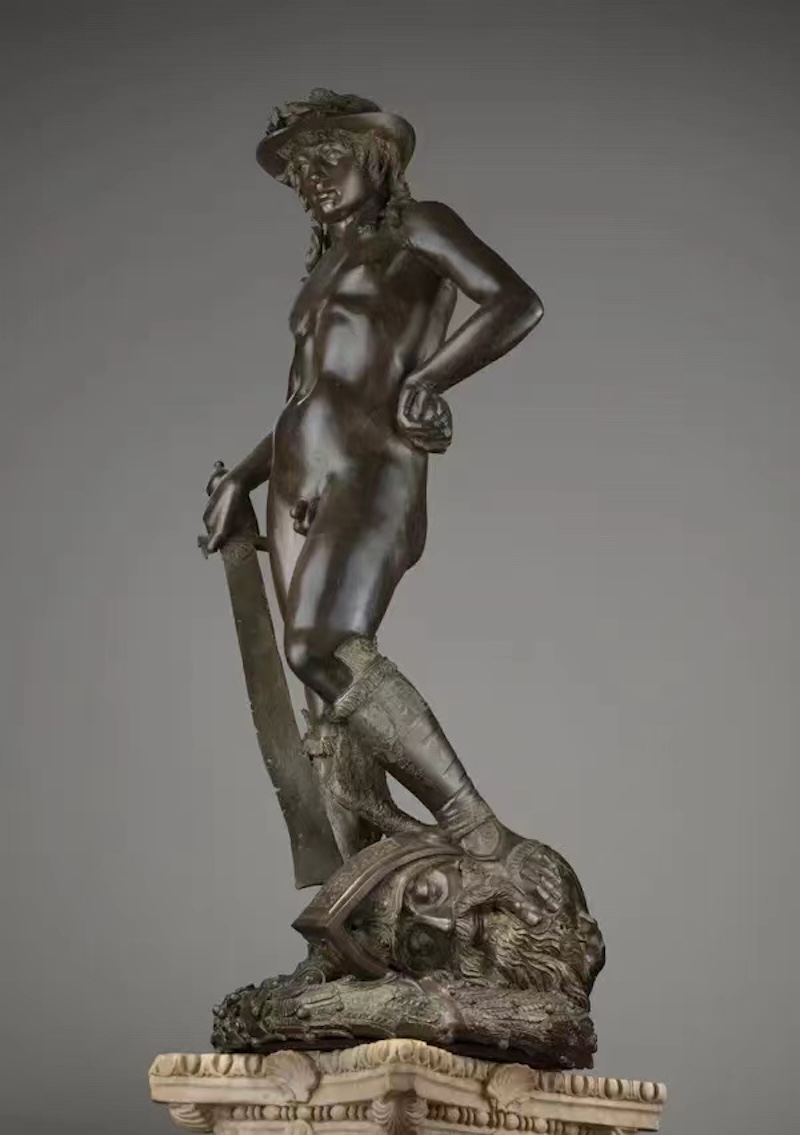
Donatello's bronze sculpture "David"
Note: Wang Lianming is an associate professor in the Department of Chinese and History at the City University of Hong Kong. I would like to thank him, Lu Jia (doctoral student at WAI), and Shanghai International Studies University Institute of World Art History (WAI) for their great assistance in this article. The "Lecture by Outstanding Scholars in World Art History" will open in September 2023. The theme of the 2023-2024 year is "Art and Culture during the Renaissance". Twelve first-class scholars from six countries will be invited to China to share research results in this field.
